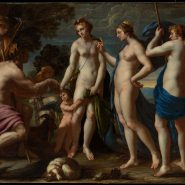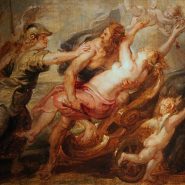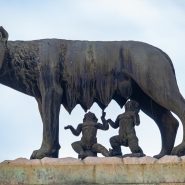Overview
The abduction of Proserpina is one of Rome’s most enduring and symbolic myths — a story of loss and renewal, darkness and return, and the eternal rhythm of nature’s seasons. It tells of a daughter taken from her mother, of a mother’s sorrow that withers the earth, and of the balance between life and death that sustains the world.
Through this tale, the Romans explained the turning of the year, the descent of winter, and the rebirth of spring, seeing in Proserpina’s journey the endless cycle of decay and renewal that governs both gods and mortals alike.
The Maiden of Spring
Proserpina, daughter of Ceres and Jupiter, was the goddess of budding life — youthful, radiant, and beloved by all. She wandered the meadows of Sicily with her companions, gathering wildflowers beneath the golden light of her mother’s care. The fields flourished wherever she walked, for her laughter was spring itself, and her touch awakened the sleeping seeds of the earth.
But her beauty caught the eye of one who dwelled in the shadows: Pluto, lord of the underworld. He longed for her light to warm his dark realm, and his heart, untouched by joy until that moment, was seized with love and desire. When he sought Jupiter’s counsel, the king of gods gave a silent nod — for all realms must be filled, even those below.
The Abduction
One morning, as Proserpina stooped to pluck a bloom of extraordinary beauty, the ground beneath her feet began to tremble. From the depths of the earth burst Pluto in his black chariot, drawn by four immortal horses. Before the maiden could cry out, he swept her into his arms and vanished into the gaping fissure that closed behind them.
The meadow fell silent, the flowers drooped, and the sunlight dimmed. Only a few blossoms, torn from her hands, remained to tell of her passing. The nymph Cyane, who witnessed the abduction, wept so bitterly that her tears became a river, flowing forever in sorrow for the lost goddess of spring.
The Despair of Ceres
When Ceres returned and found her daughter gone, she tore her veil and wandered the earth in grief. Disguised as an old woman, she roamed from city to city, bearing a torch in each hand to light her search by night.
She visited kings and shepherds, oceans and mountains, but found no trace of Proserpina. As her sorrow deepened, the earth itself began to mourn with her. Crops withered, leaves fell from the trees, and the fertile fields turned to dust. Famine spread across the world, and mortals lifted their prayers in vain. The gods themselves grew anxious, for the worship of humankind — their offerings and altars — had ceased.
At last, the sun god Sol, who sees all from his chariot above the sky, revealed the truth to Ceres: her daughter had been taken by Pluto to rule as queen beside him. Enraged, she ascended to Jupiter’s throne and demanded her child’s return, threatening to destroy the world if Proserpina were not restored. Moved by her plea, Jupiter sent Mercury, the divine messenger, to carry his decree into the underworld.
The Bargain of the Underworld
Mercury descended to the shadowed halls of Pluto and delivered Jupiter’s command. Pluto, unwilling to defy his brother yet unwilling to lose his bride, consented — but not before tricking fate to bind her to him.
He offered Proserpina a pomegranate, the food of the dead. Unaware of its power, she ate a few bright seeds. When Mercury led her away, the Fates declared that because she had tasted the fruit of the underworld, she could never be entirely free of it.
Thus a compromise was made: for part of each year, Proserpina would dwell with her mother in the sunlight, bringing spring and summer; for the other part, she would return to Pluto’s realm, ushering in autumn and winter. So were the seasons born — a divine reflection of joy and sorrow, reunion and loss.
The Return and the Cycle
When Proserpina rose from the underworld, Ceres ran to meet her, and the world burst into bloom once more. Flowers returned, fields revived, and the air filled with birdsong. Every year thereafter, when Proserpina returned to her mother, the earth rejoiced; when she descended again to Pluto’s side, it mourned.
The myth became the Romans’ sacred explanation for the cycle of the seasons — nature’s eternal promise that even in darkness, life waits to be reborn. For as the goddess of spring departed each year into shadow, her mother’s grief blanketed the world in winter’s sleep, and as she returned, the world awakened anew.
Meaning and Legacy
The story of Proserpina’s abduction and return was central to Roman spirituality, symbolizing the rhythm of death and rebirth that governs all creation. It spoke of the balance between loss and renewal, between the upper and lower worlds, between the mother who gives life and the daughter who endures its passage.
In mystery cults devoted to Ceres and Proserpina, initiates found comfort in the belief that the soul, like the seed, would rise again after darkness. For Romans, the myth was not a tragedy but a promise — that no winter is eternal, and that every descent into shadow carries the hope of spring’s return.
Adapted from public-domain materials, including Project Gutenberg and Wikisource.
